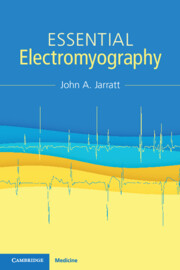Book contents
- Essential Electromyography
- Essential Electromyography
- Copyright page
- Dedication
- Contents
- Figures
- Diagrams
- Tables
- Preface
- Acknowledgements
- Abbreviations
- Chapter 1 Introduction
- Chapter 2 Basic Anatomy and a Little Physiology
- Chapter 3 Peripheral Nerve Types
- Chapter 4 Peripheral Nerve Function
- Chapter 5 The Neuromuscular Junction
- Chapter 6 Muscle
- Chapter 7 Some Technical Matters: Electrodes, Stimulators, Amplifiers, Display, Averagers
- Chapter 8 Volume Conduction
- Chapter 9 Pathology
- Chapter 10 Electromyography (EMG)
- Chapter 11 Nerve Conduction Studies (NCS): Introduction
- Chapter 12 Nerve Conduction Studies: Normal
- Chapter 13 Nerve Conduction Studies: Degeneration
- Chapter 14 Nerve Conduction Studies: Demyelination
- Chapter 15 Degree of Pathology
- Chapter 16 Tests of Neuromuscular Transmission
- Chapter 17 Other Techniques: F-waves and H-reflexes
- Chapter 18 Clinical Applications
- Chapter 19 Other Stuff: Aberrant Nerve Pathways, A-waves, EMG Anomalies
- Chapter 20 Normal Values
- Chapter 21 Conclusion
- Glossary
- Further Reading
- Index
Chapter 4 - Peripheral Nerve Function
Published online by Cambridge University Press: 14 September 2023
- Essential Electromyography
- Essential Electromyography
- Copyright page
- Dedication
- Contents
- Figures
- Diagrams
- Tables
- Preface
- Acknowledgements
- Abbreviations
- Chapter 1 Introduction
- Chapter 2 Basic Anatomy and a Little Physiology
- Chapter 3 Peripheral Nerve Types
- Chapter 4 Peripheral Nerve Function
- Chapter 5 The Neuromuscular Junction
- Chapter 6 Muscle
- Chapter 7 Some Technical Matters: Electrodes, Stimulators, Amplifiers, Display, Averagers
- Chapter 8 Volume Conduction
- Chapter 9 Pathology
- Chapter 10 Electromyography (EMG)
- Chapter 11 Nerve Conduction Studies (NCS): Introduction
- Chapter 12 Nerve Conduction Studies: Normal
- Chapter 13 Nerve Conduction Studies: Degeneration
- Chapter 14 Nerve Conduction Studies: Demyelination
- Chapter 15 Degree of Pathology
- Chapter 16 Tests of Neuromuscular Transmission
- Chapter 17 Other Techniques: F-waves and H-reflexes
- Chapter 18 Clinical Applications
- Chapter 19 Other Stuff: Aberrant Nerve Pathways, A-waves, EMG Anomalies
- Chapter 20 Normal Values
- Chapter 21 Conclusion
- Glossary
- Further Reading
- Index
Summary
The maintenance of membrane potential is explained. The changes during depolarisation and subsequent repolarisation are described. The structure of the peripheral nerve determines its conduction velocity by virtue of its diameter and whether or not it is myelinated. The effect of the high resistance of myelin is usually well understood but that of its low capacitance much less so. This is addressed. The concepts of absolute and relative refractory periods are described, as well as how these govern the firing frequency of the nerve and the direction of nerve impulse propagation.
Keywords
- Type
- Chapter
- Information
- Essential Electromyography , pp. 10 - 13Publisher: Cambridge University PressPrint publication year: 2023

